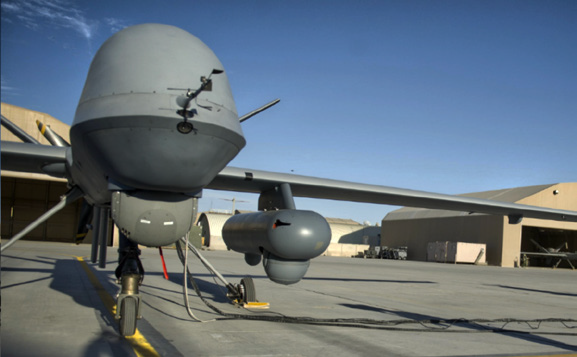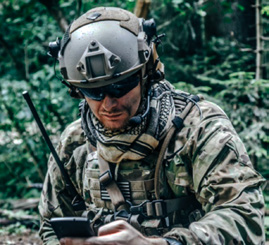The cornerstone of today’s multi-domain warfare concept is the ability to collect and use Intelligence, Surveillance, and Reconnaissance (ISR) data quickly and efficiently to accelerate decision capability.

While modern militaries have become incredibly adept at generating data, and are making leaps and bounds in their ability to process it, there are still significant limitations in the end-to-end process of turning data into actionable information, including the actual transmission of data.
Satellite networking has been a trusted method of connecting military operators in remote locations and austere environments, and now nexgen advancements are removing one of the key bottlenecks to faster decision capability.
The Challenge Military and intelligence agencies around the world have placed a high priority on improving their ability to gather and analyze critical data to enhance situational awareness, improve command and control capabilities, and expedite the decision-making process.
To accomplish the aforementioned taks, the defence industry has progressed along the data value chain with several disruptive technologies that, individually, have created bespoke solutions. Rapid advancements were made in the ability to collect data from drones and satellites deploying systems, such as Gorgon Stare, that is able to collect several gigabytes of data a minute.
Then the focus became advancing big data and analytics functions to process and exploit the massive amounts of resulting information. This led to prioritization and rapid development of AI and machine learning functions to help convert this information into valuable insights.
Collectively, these capabilities have vastly accelerated the ability to convert data into actionable intelligence, however, the heavy lifting is still largely done at the data center level. The next step in accelerating the full ISR ecosystem needs to be the data transport that feeds the algorithms and shares the resulting insights with operators at the network edge.
Information Dissemination Redefining the Network Edge

An MQ-9 Reaper with Gorgon Stare prior to a sortie at
Kandahar Airfield, Afghanistan. Photo is courtesy of U.S.
Air Firces Central
In spite of major advancements in data processing, the ability to exploit ISR data at the network edge is still quite limited, relative to the data collection capacity.
While advancements in edge processing are enabling specialized hardware to run algorithms at the edge, limitations in Size, Weight and Power (SWaP) in remote, austere environments will necessitate a balance between what can be done at the edge and what must be done at the data center level.
In other words, the facilities with the processing power to handle the largest algorithms and reference data sets (that potentially offer the most valuable insights) may be time zones or even continents away from the operator in the field. Getting the “corrrect” answer is only valuable if such is obtained before the adversaries.
Satellite Communications Enabling ISR
Satellite communications infrastructure plays a critical role in enabling the seamless collection and transmission of ISR data by drones and other platforms for Beyond Line of Sight (BLOS) connectivity.
“We must become data-centric and exploit the data that we collect.” General Sir Patrick Sanders Commander Strategic Command, Ministry of Defence — Data Strategy for Defence

"So, a large part of our job is figuring out the ways to manage that data, so that the data that's effective for decision making is front and center for decision-makers when they need it." Craig Martell, U.S. DoD Chief Digital and Artificial Intelligence Officer — 2022 DODIIS Conference
Satellites serve as a vital link in the ISR chain, facilitating the timely and secure transmission of information from remote areas to decision-makers located elsewhere. Not surprisingly, the satellite industry has undergone several technical innovations to help support the data value chain as well.
Today’s commercial satellite providers are integrating software-defined networking and SD-WAN to enable dynamic and efficient resource allocation, multi-orbit satellite constellations that expand coverage and reduce latency, and high-throughput satellites that deliver the data speeds and capacity necessary to support ISR data transmission.
The Intelsat high-throughput satellites deliver higher power signals for sensor data, video transmission, and communication relay which allows higher COTM data rates that use a smaller antenna.
At the edge, a host of new smart edge devices, including flat panel antennas, edge computing, and software-defined modems, enable the extension of 5G networking to the user, and local deployment of high- value applications.
Video compression technology has emerged as a game- changer in expediting the processing and analysis of ISR data. By compressing image and video feeds, the size of the files transmitted through satellite communications networks can be reduced significantly, ensuring faster delivery to locations with various analytical options for image analysis and exploitation.
Together, these network advancements are accelerating both the flow of data to the algorithms and the processed insights to the operator in the field. Combining these smart edge devices with advanced, multi-orbit, high throughput satellite networks, providers such as Intelsat are increasing their ability to disseminate critical intel to the warfighter, with greater speed, resilience, and security. Ultimately, this enables data analysts to better use video content, and provide insights to help operators at the network edge make better, more informed decisions faster.
Additionally, satellite transmission delivers the data via a private network offering continuous vulnerability scanning,nintrusion detection, and encryption all while ensuring your data never touches the public network.

Conclusion
Real-time data collection and transmission enable swift and accurate responses to emerging threats or changing circumstances. ISR capabilities, supported by advanced satellite communications infrastructure and video compression technology, are indispensable in enhancing situational awareness, improving command and control capabilities, and expediting the decision- making processes.
The fusion of these elements empowers military, security, and emergency response personnel with real-time insights, enabling them to respond effectively to evolving operational scenarios. By leveraging the power of these technologies, decision- makers can reduce response times,b enhance operational effectiveness, and increase the safety and security of personnel on the ground.

Rory Welch
As technology continues to advance, the synergy between ISR, satellite communications, and smart edge devices will undoubtedly play a pivotal role in achieving superior outcomes and ensuring mission success in an increasingly complex and interconnected world.
www.intelsat.com/governments-ngos
Author Rory Welch is the Vice President of International Government Services at Intelsat


